Your Planets
Portraits of the Planets
Aspects between Planets
The planetary ages
The planetary families
Planets in Signs
The Planets in comics


The lunar stage lasted a little less than a month, the mercurian stage almost two months venusian stage four and a half months. Before approaching the solar stage, also four and a half months long, the baby has learned to feel at ease, in harmony with its surrounding environment (Moon), to communicate, to make contact in all directions, to be surprised by what surrounds him and to exercise his spontaneous curiosity (Mercury), then to get attached, create links with others and discover their sensoriality as well as the power of their desires (Venus). What progress in a few months! The unfinished, undifferentiated being, full of potentialities still in gestation from the first month, has changed into a sociable and talkative, affectionate and sensitive individual.

It is around eight months that finally begins to unify what is called the “perceptual field” of the child. Until one month, this perceptual field was homogeneous, global, undifferentiated: hearing, sight, smell, taste and touch merged into one. “all-perceived”. Up to three months, this original perceptual globality exploded, became different until the baby was plunged into a maelstrom of perceptions without links between them; up to eight months, he gradually learned to coordinate his perceptions, to make them work together. At one year, the duration of the Earth’s revolution (and therefore, seen from the Earth, from the Sun), its perceptual field is completely unified. The “conscious brain” is now in control, centralizing, coordinating and interpreting all perceptions, and allowing the baby to clearly represent the world around him.
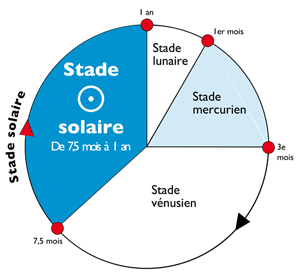
Around eight months, the baby therefore begins to forge images, representations, permanent and precise patterns of objects, beings and situations. Specialists call this new ability the “object permanence”. To better understand this phenomenon, let’s go back a little: at six months, for example, the baby is able to seek out and take a cube, or, if it is not within reach of his hands, to cry out for it get, but only if any part of that object is in its field of view. If this cube is hidden under a cloth, the baby forgets it and then behaves as if the cube no longer existed for him. The object therefore does not have a permanent reality for him: it only exists if it is visible, partially or totally.
At nine or ten months, his attitude changes completely: put in the same situation, he lifts the fabric to find the cube and if, under his eyes, the object is hidden again under a fabric of another color or under a paper, he will look for the cube under the first cloth. This time, the hidden object continues to “exist” for the child, even if he is no longer visible. The object has therefore acquired a permanent reality in the child’s brain, in the form of a mental image. The fact that the baby looks for the cube in its first hiding place when it “should” look for it in the second shows, on the one hand, that it is not very sensitive to concrete changes in the situation (when it could observe it, it takes no account of the change of hiding place), and on the other hand that, whatever the concrete hiding place which masks the concrete cube, the abstract cube, that is to say the representation of the cube not-visible, remains permanent in his brain. This is why the child of this age is said to have acquired object permanence. The hidden, invisible cube continues to exist in his head as an image. There “reality” of the cube is no longer dependent on immediate sensory perception.
The acquisition of the permanent object schema constitutes a real small revolution in the child. It is thanks to it that the notions of space will be constituted (if the object is not there, it is elsewhere), of time (if the object is not there in this moment, it was there before and it may be there after) and of causality (if the object is no longer there now, it has been moved or hidden). It is always thanks to this permanent object scheme that the baby can become aware of his individuality: if the objects exist independently of him, he himself exists independently of them.
The same attitude is observed in the relationship between the baby and the people around him, and in particular his mother: he now has in his brain a clear representation of his mother and his relationship with her and, if the mother is not not present in his eyes in the room where he is, he can give himself the objective of going to find her where she is. Because from eight months, the child acts more and more often according to goals to be achieved. And isn’t a goal an image, a mental representation that tears us away from our immediate present to project us into another dimension of time: the future?
Between eight and twelve months, therefore, the baby begins to have a clear mental image of his environment, which favors an increasingly precise identification of the beings and objects that are there. Thanks to these mental images, he can therefore now set goals, objectives, programs of action, all the more easily since he can now stand while clinging to furniture or a helping hand, and walk, or at the very least crawl towards the objects or people he has decided to approach.
Setting goals, objectives to achieve, also means exercising your conscious will, knowing precisely what you want. It’s no longer the “desire-temptation” of the previous stage, it is to show a clearly displayed intentional activity, which in no way depends, in theory at least, on the circumstances of the present situation. By setting goals, the child discovers his power of decision. He must define a direction, give himself orders of priority, refuse to be distracted by side effects, sacrifice immediate and sure satisfactions for the benefit of other more uncertain ones, give himself a line of conduct and stick to it, to be fully focused on achieving the goal he has set himself.
It’s not easy for adults. Think then of the enormous efforts that the baby must make discovering the delights but also the constraints imposed by the conscious will: he can no longer do anything as he pleases, he must learn to resist fleeting temptations to achieve for its purposes. Put yourself in his place. For example, baby decided to go find mom in the kitchen. For this, he must cross his room. Along the way, her gaze catches this red rattle that makes such a pretty noise, this teddy bear with such soft fur: what temptations! No. He does not succumb to it. Stubbornly, he continues on his way to the kitchen… maybe to find that mom is not there! Voluntary deprivation of fleeting pleasures is followed by anxiety. Hard, hard to be a baby in the solar stage!
Around the age of one, the child looks at his image in the mirror and recognizes himself in it, which is by no means obvious to him: in order to achieve this feat, he needs to disregard his immediate bodily experience, to understand that the image in the mirror does not exist in itself, but that it is only a reflection of the image that he gives of himself to others, and that this image is his. Image which is very real, but which he had never imagined or suspected the existence. He can then identify with himself, have a clear representation of himself as an individual, all the more so since he can also recognize the image of a loved one next to him—his mother or his father for example — in the same mirror.
The solar stage is therefore that of self-identification: “I recognize myself in my image.” From then on, completely new problems arise for the baby: what image does he have of himself? What image does he give of himself to his parents? And among the different images of himself he can give, which do they prefer? What should he do or not do to correspond to the image that these adults, whom he is beginning to admire more than anything, expect of him, and which is most often that of a child “as good as gold” ?
Having become aware of his appearance, the baby realizes that he is a character who can play a role, who can act on his human environment through what he reflects in the eyes of others. In short, he becomes an actor, a veritable little mutt inflated with his own importance, ready to do everything in his power to capture the interest, attention, esteem and admiration of his parents and more generally of be older than him. From now on, an imperative is imposed on him: to be recognized by the society to which he belongs, that is to say by his family environment.
The solar stage sees the appearance of intentional, voluntary, deliberate sociability. From seven months to one year, the child makes four times more movements in the direction of others than during the previous seven months. And if he has discovered the permanence of objects, he is only very moderately interested in them, largely preferring the company of his fellow human beings. True, he was already extremely sociable before. But it was an unconscious, instinctive, spontaneous, natural, relaxed, involuntary sociability, requiring of him no effort, no intention, no concentration. He did not adjust to the expectations of others, but rather asked others to adjust to his own expectations.
Now that he is aware of his image and his individuality, everything has changed. The child knows what he wants: to do like the adults, and especially like his parents whom he now takes as models, in whose image he identifies with unconditional admiration. What should be done, how should we act to earn their admiration in return? The child quickly understands that it is necessary to observe them attentively and model his behavior on theirs: his behavior of intentional imitation generally triggers the applause of the family circle of which he becomes more and more the center. The more he reproduces the gestures, the attitudes, the sounds they emit, the more he is congratulated, pampered, rewarded for his adaptation to the standards.
It is at eight months, at the very beginning of the solar stage, that he understands when he is told “no”, that is to say, he realizes that there are things he must not do on pain of being reprimanded. However, any society, any culture is based on the “no”, on the forbidden, on the taboo: there are things that are not done, and those who break these quasi-sacred prohibitions are immediately excluded, rejected, marginalized. Precisely everything that the child of eight to twelve months hates, eager for public recognition, inclusion in the family circle, integration into adult society. His obedience to “no” that is imposed on him therefore marks his entry into socio-culture: to be admitted, recognized, valued, admired, one must do like the others, comply with habits and customs, permits and prohibitions, morals and ethic of his milieu and his time, accepting to allow himself to be internally structured by rules imposed from outside.
It is therefore at the solar stage that his first models are structured, his first cultural behaviors that the baby will scrupulously reproduce. To maintain the esteem of his parents, he now refrains from certain spontaneous behaviors, inhibits certain behaviors which he has noticed that adults do not like, and voluntarily adopts new ones, more in line with family rites. He does his best to respect the instructions imposed on him, the orders given to him. Obediently accepting all these conventions, he becomes conventional. The messy, undisciplined and capricious child of the first months has turned into a model child driven by a true ideal of perfection to always live up to what his parents expect of him, and to live up to the image that wants to give them of himself. The solar stage sees the birth of narcissism, of the ideal self-image (‘rR’).
During the first year, the baby acquires, by listening and involuntary imitation, all the fundamental repertoire of sounds which will serve as a basis for learning the first words. Around eight months, he practices echolalia, that is to say the conscious imitation of the sounds emitted by others, even if he does not yet understand the precise meaning of the words. At nine months, in a normal evolution, he says “Mom” And “dad”. At ten or eleven months, he utters at least two words with meaning and at one year he utters at least three.
It is therefore during the solar stage that the baby learns the rudiments of verbal language, which marks a capital evolution in his relationship to the world: he who until then wondered about the world, felt it emotionally without being able to understand it. intellectually, here he is entering for the first time in this world for him magic, mysterious, impalpable, invisible, extraordinary: the world of words.
In fact, at eight months, the baby, by dint of “dialogue” through meaningless sounds with his mother, has already learned all the conventions that structure language. But now, these conventional codes can be used to designate specific beings, objects or situations. Precision: a key word for the baby. For him, language must be clear, transparent, unambiguous, immediately understandable: how to find one’s bearings in this new world if each unique word does not correspond to a unique thing? How to follow an instruction if it is not precisely stated, and always in the same way? Verbal language “solar” is in fact a proto-language: it is only around the age of two that he will truly learn conventional language. For the time being, in the brain of the child of this age, the word must be an absolutely faithful reflection of the thing, be completely identified with it, allowing him absolute understanding, on pain of absolute incomprehension on his part.
Information published in Release of 28/10/1997: “At eight or nine months, babies do not understand the meaning of words. But to test their memory, Peter Juscyk and Elisabeth Hohne from the University of Baltimore (USA) made fifteen of them listen to three short stories… ten times each for ten days. At home, seated on a chair, the children were also treated to the reading of a long list of words recorded on magnetic tape. Half came from the stories, the others were decoys, trap words with the same sounding. Two weeks after this operation, babies are again entitled to this list of words. The two researchers could then see that they were more attentive to those drawn from the stories. In ten days, they had therefore been able to extract words from a continuous flow of words, and retain them. It remains to be seen how.”
This very recent experiment in psychogenetics perfectly illustrates the relationship of the child to language at the beginning of the solar stage: in the midst of a multitude of sound-phonemes, they know instinctively, in an innate way, to distinguish the “true” words, not for what they mean, but for what they are. The word, the basic unit of language, is recognized for what it is.
Recall that the Jupiterian word means, describes, illustrates (‘r’) a lived, experienced, experienced reality (‘E’), while the word uranian means, describes, illustrates (‘r’) an abstract, complex, unobvious reality (‘T’). For the Uranian word as for the Jupiterian word, there is a clear difference between the signified (level-source ‘E’ or ‘T’) and the signifier (level-goal ‘r’). In the case of the word solar, the signifier (‘r’) is the signified (‘R’). It is not a descriptive language of something other than language, but a self-referential language. No need therefore, basically, to understand the meaning of the words: it is enough to know how to identify them effectively and precisely (‘r’) and memorize them, without wondering where they come from (“non-tT”) or what they serve (“non-eE”). At the solar stage, the word is no longer confused with a distracting phoneme (‘tR’ of Mercury) nor with a moving phoneme (Venus ‘eR’). It becomes a meaningful phoneme (‘rR’): everything is ready for the subsequent acquisition of the conventional language, which is the Jupiterian language. But before that, the child will have to go through the burn of confrontation with tangible realities, far from words and phonemes. This is the object of the Marsian stadium. Once again, the most recent work in psychogenetics confirms the Theory of Ages…
The discovery that he is a distinct individuality, an individual in his own right endowed with a precise identity, is accompanied in the child from eight to twelve months by an exacerbated awareness of his uniqueness. We have already observed it by evoking its social behaviors: such as the Sun at the center of the solar system, he must be the sole focus of the family unit. This is also noticeable in the way he knows how to move objects that separate him from an objective, but is unable to do the same for others. He knows very correctly how to situate all things in relation to himself, to what for him is an obvious and absolute central position which he is the only one to occupy, but never situates himself in a collective space, such as his he thought he was the center of the universe around which everything revolves and is organized.
It is during this stage (generally around nine months… i.e. the duration of the possible gestation of a little brother, a little sister!) that a new feeling appears for the first time: jealousy. And jealousy is precisely the refusal and the anguish of not being the only object of love and interest of the parents. The desire to be unique also goes hand in hand with an acute and finicky sense of hierarchy: between eight and twelve months, babies show little interest in other children; he prefers contact with adults, whom he imitates and who value him, and to whom he submits in order to enter and remain in their good graces.
When he has relations with other children, the same hierarchical sense can be observed: if he finds himself with a baby at least three months older than him, he is content to admire, submissively, the parades of the child-this. If he finds himself with a baby who is at least three months younger than him, he is the one who parades and who plays the role of the dominant; and finally, if the age difference between them is less than two months, jealousy is the source of conflicting relationships.
Without it being necessary to dramatize it to excess, this phenomenon is however perceptible towards one year, when at the end of the solar stage, the baby realizes that the claim of his individuality can only lead him to find himself separated from with his mother. All the fundamental knowledge that he acquired, repeated and reaffirmed for a year in his company risks being called into question by his accession to independence. In fact, at the solar stage, he is deeply identified with his mother who represents for him the very image of the absolute certainty of evolving in a clear, known and elucidated world, the cornerstone of everything that makes sense for he, the only person capable of permanently recognizing him, the unique model that structures all the knowledge acquired until then. To live his individuality in complete independence is for him a threat of chaos. The baby in the solar stage abhors uncertainty and the unknown.
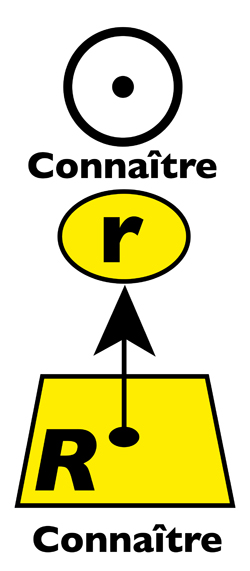
We are in solar state, like the child from 7 1/2 months to 1 year, when we are a priori convinced of the correctness of our point of view, when we forcefully reaffirm our certainties and our convictions by removing from our mind the slightest doubt, the slightest hesitation, the smallest restriction. We are in a solar state when we place above all our sense of honor, of dignity, when we refuse, whatever the circumstances, to lower ourselves to behaviors, acts or thoughts which we consider to be it would be degrading in our own eyes to abandon ourselves to it. We are in a solar state when we do not compromise on our essential principles, when we are ready to sacrifice everything for an ideal which for us is indisputable, a cause which seems absolutely fair to us and with which we identify completely, when we adhere passionately, without reservation, to a clear and unifying theory or worldview.
We are still in a solar state when we admire, adulate, respect a being, a thing or an idea more than anything in the world, to the point of wanting to imitate him in every way, to take him as the only model, as the only reference, as source of all our identifications, as an example to follow for all our attitudes in life. We are in a solar state when it is unimaginable for us not to live up to what this being or this idea expects of us and we expect in return to be admired, adulated, respected, recognized by him.
We are in a solar state when we are ultra-sensitive to the image we give of ourselves to others, when we are hyper-vigilant about our social impact, when we affirm and ensure with pride and pride our image of brand, when we want to be recognized at all costs by repeating ourselves, when we adopt exemplary behavior. We are in a solar state when the recognition of others appears to us as our due, an obviousness which imposes itself from the start, a primary requirement that we do not have to conquer, when we are ready for anything not to disappoint others, to meet their expectations, to attract their attention, to become a unique center of interest.
We are always in a solar state when a clear goal, a precise objective, a stated ambition imposes itself on us with such power and such force of evidence that nothing can distract us from our obsessive desire to achieve this goal, to achieve this objective, to reach the end of this ambition, even if it means sacrificing our present, our immediate satisfactions and putting a damper on our possible inner reluctance. We are in a solar state when we feel absolutely convinced that we know exactly where we are going, that we have no doubts about the route fixed once and for all, the program to be fulfilled, the plan to be followed to the letter.
With a strong and dominant Sun in his birth chart, the individual very frequently experiences these solar states: we will then say that he is an idealist, a principled being, a proud man concerned about his brand image, an ambitious man eager to recognition that seems impervious to doubts, emotions and moods. If the Sun is weak and non-dominant in its chart, the individual may experience great difficulty in identifying with motivating ideals, in being concerned about its social impact, in imitating any model whatsoever. He will find it difficult or will refuse to impose clear, straight, strict and demanding guidelines for himself, and to stick to them at all costs.
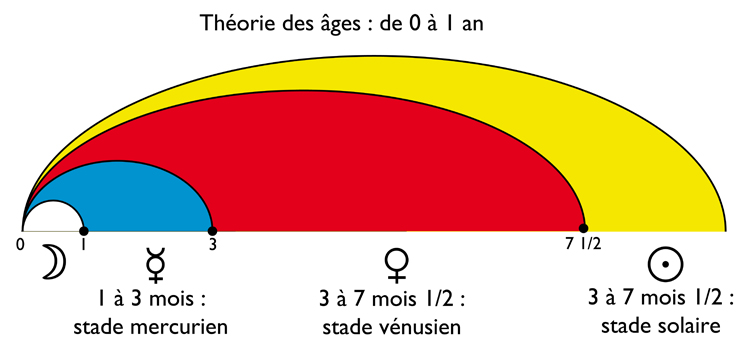
It is during the 1D year that we do the functional learning to which the three planets (Sun, Venus, Mercury) belonging to the level ‘R’ (“Extensive representation”). This fact deserves some reflection and deepening.
There “Extensive Representation”, as we have seen, involves preliminary reading grids, “maps” which allow you to explore the territory and meet the unknown. This implies that there are innate, genetically and astrally transmitted structures that would give the possibility of automatically learning language, if the environment allows it: “As the baby grows and moves towards mastering a natural language, we see a series of stages that seem to depend more on a ‘biological clock’ than on the environment”. In other words, “We don’t have to learn to coordinate the different data of our senses to extract objects from them, miraculously. From the outset, the perceptual world is organized, and this, because it refers to abstract representations that are originary. They provide, in a way, schemas that make it possible to establish correspondences between stimuli.”
These are indeed proto-representations, innate schemas, a mapping a priori inscribed in our brain. On this subject, it is particularly interesting to evoke the progressive appearance of language.
We know that babies, up to one month “talk” all exactly the same language, or more exactly cry and wail according to identical intonations, whether they are French, Turkish, Tibetan or Bantu. Then comes the time of incomprehensible tweets, followed by emotionally interpretable tweets (the “pre-verbiage”), the whole being crowned by the first word, around 1 year. In the broad sense, children under one year old essentially emit phonemes. It turns out that from birth to 1 year, the sound field keeps shrinking. And at 1 year, only the most frequently heard sounds are retained, that is to say those that belong to the socio-culture (mother tongue) of the baby.
In other words, at the Mercurian stage (‘tR’, from here to far away), we emit signals (‘R’) which retain a relative universal scope (‘t’). At the Venusian stage (‘eR’, from here to near), the range of signals is reduced according to the languages of connivance that we must use to make ourselves understood by our loved ones. Finally, at the solar stage (‘rR’, maintenance of here), only the significant signals of the mother tongue make sense, and therefore the only ones worthy of imitation and reproduction: “By reducing the range of sounds he is prepared to hear, the baby becomes able to deal more easily with those that deserve his attention…similarly, by reducing the range of sounds he produces, he becomes more capable of integrating its sounds into words” (Doure).
Thus the solar function allows us to hear and reproduce only what makes sense to us. Thus we are, from our first year, structured and animated by proto-representations which only become conscious little by little: “Thus, it is perfectly possible, and even plausible, that the model of the physical world is expressed in the newborn only in the form of a few fairly primitive mechanisms, similar to precursor behaviors.”
▶ The Solar: Psychological profile
▶ The solar function ‘rR’ (representation of Representation)
▶ Pouvoirs de Soleil-Lune : le Soleil
▶ Sun-Mars-Pluto: extensive Power
▶ Apollon et son ombre : quand le Soleil se fait violence
▶ Sun-Mercury-Venus: extensive Representation
▶ Sun-Jupiter-Uranus: intensive representation
▶ Introduction to the Theory of Planetary Ages
▶ L’échéancier planétaire et la Théorie des âges
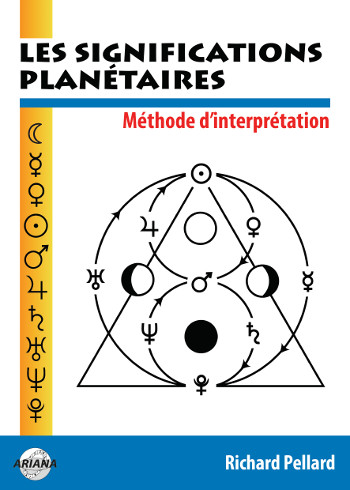
Les significations planétaires
par
620 pages. Illustrations en couleur.
La décision de ne traiter dans ce livre que des significations planétaires ne repose pas sur une sous-estimation du rôle des Signes du zodiaque et des Maisons. Le traditionnel trio Planètes-Zodiaque-Maisons est en effet l’expression d’une structure qui classe ces trois plans selon leur ordre de préséance et dans ce triptyque hiérarchisé, les Planètes occupent le premier rang.
La première partie de ce livre rassemble donc, sous une forme abondamment illustrée de schémas pédagogiques et tableaux explicatifs, une édition originale revue, augmentée et actualisée des textes consacrés aux significations planétaires telles qu’elles ont été définies par l’astrologie conditionaliste et une présentation détaillée des méthodes de hiérarchisation planétaire et d’interprétation accompagnées de nombreux exemples concrets illustrés par des Thèmes de célébrités.
La deuxième partie est consacrée, d’une part à une présentation critique des fondements traditionnels des significations planétaires, d’autre part à une présentation des rapports entre signaux et symboles, astrologie et psychologie. Enfin, la troisième partie présente brièvement les racines astrométriques des significations planétaires… et propose une voie de sortie de l’astrologie pour accéder à une plus vaste dimension noologique et spirituelle qui la prolonge et la contient.
Téléchargez-le dès maintenant dans notre boutique
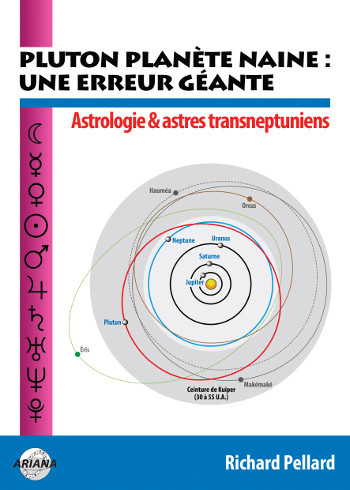
Pluton planète naine : une erreur géante
par
117 pages. Illustrations en couleur.
Pluton ne fait plus partie des planètes majeures de notre système solaire : telle est la décision prise par une infime minorité d’astronomes lors de l’Assemblée Générale de l’Union Astronomique Internationale qui s’est tenue à Prague en août 2006. Elle est reléguée au rang de “planète naine”, au même titre que les nombreux astres découverts au-delà de son orbite.
Ce livre récapitule et analyse en détail le pourquoi et le comment de cette incroyable et irrationnelle décision contestée par de très nombreux astronomes de premier plan. Quelles sont les effets de cette “nanification” de Pluton sur son statut astrologique ? Faut-il remettre en question son influence et ses significations astro-psychologiques qui semblaient avérées depuis sa découverte en 1930 ? Les “plutoniens” ont-ils cessé d’exister depuis cette décision charlatanesque ? Ce livre pose également le problème des astres transplutoniens nouvellement découverts. Quel statut astrologique et quelles influences et significations précises leur accorder ?
Enfin, cet ouvrage propose une vision unitaire du système solaire qui démontre, chiffes et arguments rationnels à l’appui, que Pluton en est toujours un élément essentiel, ce qui est loin d’être le cas pour les autres astres au-delà de son orbite. Après avoir lu ce livre, vous saurez quoi répondre à ceux qui pensent avoir trouvé, avec l’exclusion de Pluton du cortège planétaire traditionnel, un nouvel argument contre l’astrologie !
Téléchargez-le dès maintenant dans notre boutique